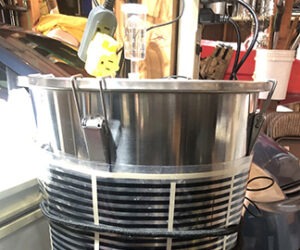Yeast Flocculation

It’s a simple process with a not-so-simple explanation. Experienced brewers know how to encourage (or discourage) it and it can be highly impactful on the flavor experience of the finished beer. Flocculation is an active process when yeast start clumping together after they finish their job of fermentation. Typically, yeast collect on the bottom of our fermenters along with trub.
When you start to dig into the process of yeast flocculation, you quickly realize that some yeast strains are better at it than others. Yeast suppliers will use terms like, “a highly flocculant yeast strain” in their descriptions. So, what does make a yeast strain better at the process of flocculation? Simply put, some cells are more prone to stick together. The larger these yeast clump aggregates become, the heavier and more prone they are to gain the necessary critical density to overcome Brownian motions that are keeping cells afloat in our beer.
Why Does Flocculation Matter?
Yeast flocculation matters for a few reasons. First, there are reasons brewers don’t want suspended yeast in their beer as it does affect beer flavor. Brewers may choose a more highly flocculant yeast strain to rapidly clarify their beer from yeast. (It’s important to note that yeast is only one piece of the greater hazy beer phenom. For example, it’s typically suspended protein-polyphenolic compounds that cause the cloudiness in hazy IPAs and not yeast.) A brewer may want to turn a beer around in a week and will use a strongly flocculant yeast strain to produce a clear, bright beer in such a short timeframe.
On the other hand, brewers might choose a less flocculant strain for other reasons. Highly flocculant strains are better known to drop out of suspension too soon if not handled properly, leaving an unfinished fermentation and an overly sweet beer. Less flocculant yeast strains are typically known to finish fermentation strong. Also, certain styles of beer call for some yeast in suspension. German wheat beer and Belgian witbiers are two prime examples. Some brewers instruct the drinker to swirl the bottom dregs of the bottle to resuspend the yeast for consumption. In these low-hop beers, the yeast can provide a nice, rounded mouthfeel to the beer.
Promoting Flocculation
Besides yeast selection, there are other ways in which brewers can promote the yeast to fall out of suspension upon completion of fermentation. Yeast nutrients are an easy way to promote flocculation. Calcium is the major player in this dynamic by activating compounds known as lectins on cell walls of yeast. Once activated, the lectins can adhere to other yeast cells and begin the flocculation process. Be sure to follow the manufacturer’s instructions for usage rates and timing of any yeast
nutrient addition.
Proper oxygenation/aeration of the wort when using a liquid strain (new or re-using a strain) is another key to achieving stronger flocculation from yeast. An aquarium pump attached to a HEPA filter with a 0.5- to 2-micron sinter or diffusion stone is a cheap and easy way to aerate wort.
Temperature is another key factor in promoting the process. While certain yeast strains, especially some lager strains, may flocculate better if warmed after fermentation, when chilled to near-
freezing temperatures, most yeast cells will eventually fall from suspension. Allowing yeast to get too cold too early in the fermentation cycle is a prime reason that highly flocculant yeast may stall out and not finish fermentation.
Post-fermentation treatments such as clarifying agents and/or filtration are another way yeast can be removed from suspension. There are many clarifying agents available for different purposes, so you just need to be sure you choose one that is for yeast sedimentation.
Getting Geeky
It can be deduced from earlier sections that not all brewing yeast strains are created equally. Highly flocculant yeast cell walls appear differently than low flocculating yeast strains under a scanning microscope. For yeast that don’t actively flocculate, it turns out they appear to lack the lectins necessary to promote flocculation and have smooth cell walls instead. Highly flocculant yeast have more of a Velcro appearance to their cell walls.
What triggers the lectins to start to attach to compounds on other yeast cells is still just a theory, but we do know that different strains have different genotypes, which have different signals to begin the flocculation process.
Another important aspect to understand is that the genes that code for yeast flocculation are highly susceptible to gene mutations. Brewers who re-pitch the same yeast from one batch to the next find that flocculation tendencies can change quickly. A strain that cleared within a week on batch #1, may take a month to clear by batch #3. More advanced brewers can select for properly flocculating cells by choosing which layer of yeast sediment to harvest.
Conclusion
What’s most important to understand is that yeast cells will eventually drop out of suspension from your beer when given enough time. The speed at which it happens is dependent upon many factors, most notably which yeast strain is used. Understanding how to control the other factors is key to getting the beer to look and taste like you want it to.



